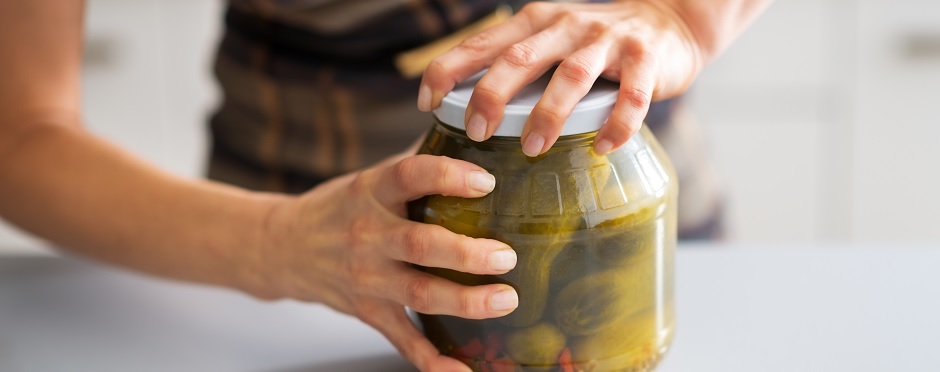
Get a Grip on Fall: Joint Protection Tips for Your Hands
Leave a CommentCo-author: Sofia Monarrez
Fall season is here! Sweater weather, crisp and chilly mornings, colorful foliage, and pumpkin flavored everything are just a few reasons to love autumn. But as you reach for your leaf rake or start cooking your favorite fall foods, let’s make sure you are protecting the joints in your hands while you make the most of the season.
Osteoarthritis (OA) is the most common type of arthritis. It is a degenerative joint disease in which cartilage, the tissue that cushions the ends of your bones, breaks down. As OA progresses, the bones in the joint start to rub together causing pain, stiffness, and swelling.1 OA commonly affects the hand,2 particularly at the base of the thumb.3 Loss of cushioning tissue in the joints of the hands means that these joints can’t tolerate as much stress, so activities involving pushing, pulling, twisting, or prolonged grip and pinch can be painful.4
What can you do to protect your hands?
Joint protection strategies and activity modifications can help reduce joint stress by redistributing the force needed to complete daily activities.5 Whether you are living with OA or want to do everything you can to keep your joints healthy, here are some tips from our Hand Therapists you can try:
- Use larger joints whenever possible: Consider carrying bags and purses over your forearm close to your elbow instead of grasping them with your hands.
- Avoid tight, prolonged grip and pinching motions: You might be eager to finish raking the leaves or writing your holiday cards at once, but consider taking rest breaks or alternating with an activity that does not involve a tight grip or pinch.
- Use two hands instead of one when lifting to distribute the weight: If you are getting a pie out of the oven or lifting a pan from the stove, use mitten type hot pads on both hands to spread the weight. When sipping on some coffee or tea, use a well-insulated cup to safely place both hands around it to lift and carry it.
- Modify current tools: Tools with wider handles help minimize joint stress as less pinch or grip is required to use them. You can wrap pens or utensils in foam for a quick DIY solution.
- Take advantage assistive tools: Opening jars and bottles are among the most difficult tasks for people with hand OA.6 Fortunately, ergonomic jar and bottle openers can help. Also consider built-up key holders to provide extra leverage and make holding and turning a key easier.
This fall season, remember these tips to minimize joint stress and maximize all the autumn activities you love most. If you experience any pain or injuries or have questions related to the hand or upper extremity, contact an Athletico hand therapist for a free assessment.
In addition to these strategies, hand therapy sessions with a skilled hand therapist can help you improve your joint mechanics, strength, and provide you with orthoses/splints to support you in your activities. Our sessions are focused on YOUR desired activities of daily living and being able to perform those activities without pain and with full independence.
Find a Hand Therapist Near You
The Athletico blog is an educational resource written by Athletico employees. Athletico bloggers are licensed professionals who abide by the code of ethics outlined by their respective professional associations. The content published in blog posts represents the opinion of the individual author based on their expertise and experience. The content provided in this blog is for informational purposes only, does not constitute medical advice and should not be relied on for making personal health decisions.
References:
1. Centers for Disease Control and Prevention. (2020). Osteoarthritis (OA). https://www.cdc.gov/arthritis/basics/osteoarthritis.htm.
2. U.S. Department of Health and Human Services. (2020). Osteoarthritis. National Institute on Aging. https://www.nia.nih.gov/health/osteoarthritis.
3. Arthritis Foundation. (2020). Osteoarthritis of the Hands. https://www.arthritis.org/diseases/more-about/osteoarthritis-of-the-hands.
4. Mayo Foundation for Medical Education and Research. (2020). Rheumatoid arthritis pain: Tips for protecting your joints. Mayo Clinic. https://www.mayoclinic.org/diseases-conditions/rheumatoid-arthritis/in-depth/arthritis/art-20047954.
5. Mcgee, C., & Mathiowetz, V. (2016). Evaluation of Hand Forces During a Joint-Protection Strategy for Women With Hand Osteoarthritis. American Journal of Occupational Therapy, 71(1). https://doi.org/10.5014/ajot.2017.022921
6. Kjeken, I., Dagfinrud, H., Slatkowsky-Christensen, B., Mowinckel, P., Uhlig, T., Kvien, T. K., & Finset, A. (2005). Activity limitations and participation restrictions in women with hand osteoarthritis: Patients’ descriptions and associations between dimensions of functioning. Annals of the Rheumatic Diseases, 64, 1633–1638. https://doi.org/10.1136/ard.2004.034900
